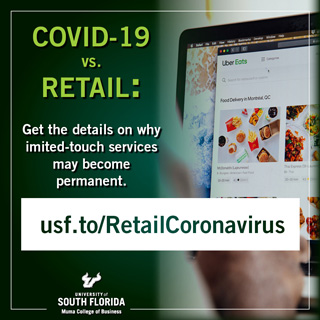News Archive
Retail Versus COVID-19: Some Changes May Become Permanent
By Rob Hammond

TAMPA (March 30, 2020) -- There is an old adage in business: “Nothing happens until someone sells something.”
Over 20 percent of the U.S. non-agricultural jobs are in retail, leisure and hospitality and those industries seem to be at a standstill, bogged down under the COVID-19 crisis that is sweeping the nation and the globe. It feels like nothing, except for toilet paper and hand sanitizer, is selling. Certainly not dinners out, movies or cocktails at the neighborhood bar. However, take a closer look and there are pockets of commerce and innovation.
So, what does all this disruption mean for the restaurant, leisure, and hospitality industries? The changes in social behavior driven by social distancing have challenged businesses, struggling to make tough decisions that impact employees and customers. Corporations are establishing lines of credit to ensure cash is available and smaller companies are hoping to do the same with the COVID-19 stimulus package. While financial measures can’t solve medical issues, they can ensure the financial ramifications are muted.
Though the market has changed, there still is a market. Sales and marketing professionals should be aware of changes in the progression of the outbreak to know when to shift messaging by region and customer. As the outbreak runs its course and therapeutic options arise, the general fear of the circumstance lifts and innovation takes root. Already there are signs of innovation. Limited touch service options are becoming commonplace with companies offering curbside pick-up, take-out liquor, and no-touch delivery. Some of these experiences are likely to be part of the new normal marketplace of the future.
For quite some time to come, diners and vacationers will be in limited supply and money will be tight for many. The limited economic activity could translate into buyers using the forced experiences of the outbreak as tools to control spending while still garnering a portion of their “previous-life” experiences.
Diners may start taking the meal and drinks home for dinner. This would put margin pressure on the hospitality sector due to the loss of high-margin items, like liquor and impact labor scheduling. Sales and marketing teams that are attuned to these changes will be best positioned to engage with their customers and prospects to solve these problems.
How long this crisis – disruption – will last is the question on everyone’s mind.
We are clearly in the middle of a significant market disruption but it’s important to remember market disruptions aren’t uncommon. In fact, it’s only been 12 years since we had our last global market disruption and there have been varied regional, local and company disruptions during this time as well.
It’s also important to recognize there are commonalities about these events and how we get through them. These commonalities can help sales and marketing professionals decide what to say to buyers and when.
Immediately after a disruption begins, and for a period after, buyers have an intense focus on safety and preparedness. For businesses, safety and preparedness mean concerns over employees and customers as well as ensuring access to cash. Next, buyers innovate to find ways to improve the situation while managing the immediate concerns for safety and liquidity. Then, after some time, businesses begin to operate in a new-normal marketplace.
The new-normal marketplace is characterized by changes in buyer behavior that resulted from buyer experiences during the disruption and follows a well-established innovation diffusion process.
Telemedicine is likely to be an example of a new normal experience following the current disruption. Consumers and health care providers are finding ways to work together, creating a landscape that may result in permanent, remote medical-care options after the crisis subsides.
More generically, during a disruption, new services are created or existing services change and buyers discover they like or can adapt to the new buyer experience. Essentially, the demand curve for a product or service changes due to forced trial and market alterations. Over the course of a disruption, we can define three distinct marketing phases.
The time after the disruption is Phase 1. The following time period is Phase 2 and the marketplace in the new normal is Phase 3. By understanding where buyers are in the market disruption phase, sales and marketing professionals can support buyers with messages and activities that are aligned with the buyers’ current problems and thus, aligned with buyers’ greatest likelihood to purchase.
In Phase 1, a company is focused on safety but also must ensure access to cash. Sales and marketing professionals can support buyers by assuring them that services are available and sharing insights on what is being done to mitigate risks. In Phase 2, the sales and marketing efforts shift to assisting buyers with innovation and operating in a new environment. Margins are likely tighter than before the disruption and some buyers will no longer be in the market. In Phase 3, buyers are focused on new experiences and growth while minimizing the risk of tying up large amounts of cash. It’s also important to note that buyers with stronger positions will move more quickly through the phases and some segments and geographies will be more impacted than others. A universal principle for engagement across all three phases is to focus on solving the buyers’ problems as opposed to selling a product.
Sales and marketing professionals must understand when to change messaging between the different phases. Timing is market driven and will vary by geography and buyer market strength so, rather than trying to guess timing – becoming a fortune teller – sales and marketing professionals should look to objective events as triggers.
In the end, we will persevere through this disruption like those before. And, as in previous disruptions, sales and marketing professionals who are focused on the buyer’s problem will reap the benefits over the long term.
Rob Hammond is an instructor in the Marketing Department and director of the Muma College of Business' Center for Marketing and Sales Innovation.